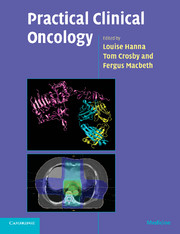Book contents
- Frontmatter
- Contents
- List of contributors
- Preface
- Acknowledgements
- Abbreviations
- 1 Practical issues in cytotoxic chemotherapy usage
- 2 Biological treatments in cancer
- 3 Hormones in cancer
- 4 Radiotherapy planning
- 5 Research in cancer
- 6 Oncological emergencies
- 7 Palliative care
- 8 Head and neck
- 9 Oesophagus
- 10 Stomach
- 11 Liver, gallbladder and biliary tract
- 12 Exocrine pancreas
- 13 Colon and rectum
- 14 Anus
- 15 Gastrointestinal stromal tumours
- 16 Breast
- 17 Kidney
- 18 Bladder
- 19 Prostate
- 20 Testis
- 21 Penis
- 22 Ovary
- 23 Body of the uterus
- 24 Cervix
- 25 Vagina
- 26 Vulva
- 27 Gestational trophoblast tumours
- 28 Lung
- 29 Mesothelioma
- 30 Soft tissue and bone tumours in adults
- 31 The lymphomas and myeloma
- 32 Central nervous system
- 33 Skin cancer other than melanoma
- 34 Melanoma
- 35 Thyroid
- 36 Neuroendocrine tumours
- 37 Cancer in children
- 38 Cancer of unknown primary
- 39 The use of radiotherapy in the treatment of benign conditions
- Multiple choice questions
- Multiple choice answers
- Index
- References
16 - Breast
Published online by Cambridge University Press: 23 December 2009
- Frontmatter
- Contents
- List of contributors
- Preface
- Acknowledgements
- Abbreviations
- 1 Practical issues in cytotoxic chemotherapy usage
- 2 Biological treatments in cancer
- 3 Hormones in cancer
- 4 Radiotherapy planning
- 5 Research in cancer
- 6 Oncological emergencies
- 7 Palliative care
- 8 Head and neck
- 9 Oesophagus
- 10 Stomach
- 11 Liver, gallbladder and biliary tract
- 12 Exocrine pancreas
- 13 Colon and rectum
- 14 Anus
- 15 Gastrointestinal stromal tumours
- 16 Breast
- 17 Kidney
- 18 Bladder
- 19 Prostate
- 20 Testis
- 21 Penis
- 22 Ovary
- 23 Body of the uterus
- 24 Cervix
- 25 Vagina
- 26 Vulva
- 27 Gestational trophoblast tumours
- 28 Lung
- 29 Mesothelioma
- 30 Soft tissue and bone tumours in adults
- 31 The lymphomas and myeloma
- 32 Central nervous system
- 33 Skin cancer other than melanoma
- 34 Melanoma
- 35 Thyroid
- 36 Neuroendocrine tumours
- 37 Cancer in children
- 38 Cancer of unknown primary
- 39 The use of radiotherapy in the treatment of benign conditions
- Multiple choice questions
- Multiple choice answers
- Index
- References
Summary
Introduction
The lifetime risk of breast cancer in women is one in nine. Breast cancer most commonly presents as a lump in the breast, but the use of screening has also allowed very early cancers to be diagnosed before they can be detected clinically. The management of breast cancer has changed dramatically. In the past, patients were treated with radical mastectomy, whereas today, patients are usually treated with breast-conserving techniques – wide local excision and radiotherapy. The past few decades have also seen the wider use and development of systemic therapies: hormonal treatments, chemotherapy and, recently, the monoclonal antibody trastuzumab. As a result, there has been a steady fall in the mortality from breast cancer.
Types of tumour affecting the breast
Table 16.1 shows the range of tumours that can affect the breast.
Anatomy
The female breast extends from the 2nd to the 6th rib, and it is made up of 15 to 20 lobes which radiate out from the nipple. The nipple is surrounded by the areola. Each breast is divided into a central portion and four quadrants. The upper outer quadrant also contains the axillary tail. The lymphatic drainage from the breast is primarily to the axillary lymph nodes but also to the internal mammary nodes, which lie in the thorax alongside the internal thoracic artery. A few lymphatic channels also communicate with those in the opposite breast and in the abdominal wall.
- Type
- Chapter
- Information
- Practical Clinical Oncology , pp. 190 - 213Publisher: Cambridge University PressPrint publication year: 2008

